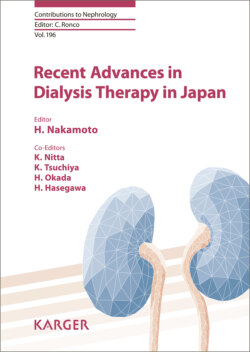Читать книгу Recent Advances in Dialysis Therapy in Japan - Группа авторов - Страница 97
На сайте Литреса книга снята с продажи.
Abstract
ОглавлениеFibroblast growth factor 23 (FGF23) is a regulator of phosphate and vitamin D homeostasis that carries out primary bone- and mineral-related physiological functions to increase renal phosphate excretion and reduce 1α-hydroxylation of 25-hydroxyvitamin D. In a negative endocrine feedback loop, 1,25-dihydroxyvitamin D also stimulates FGF23 secretion. Previous studies have assessed the correlation between vitamin D receptor activator therapy and FGF23 concentrations, and to our knowledge, none has assessed the correlation between intravenous (i.v.) maxacalcitol therapy and FGF23 concentration in hemodialysis patients. Subjects included 148 patients on maintenance hemodialysis. Serum FGF23 concentrations were measured. The correlations among serum FGF23 concentrations with i.v. maxacalcitol therapy and other clinical parameters and medications were analyzed. Mean serum log FGF23 was 3.7 ± 0.8 pg/mL. After division into two equal groups based on median serum log FGF23 level, the percentages of patients administered i.v. maxacalcitol (60/74 [81.1%] vs. 45/74 [60.8%], p < 0.01) were significantly higher in the high log FGF23 group. The amounts of serum FGF23 concentrations had been significantly higher to the amounts of i.v. maxacalcitol per week dependency. Multivariate regression analysis showed that treatment with i.v. maxacalcitol was an independent predictor of serum FGF23 levels, regardless of phosphate or calcium concentrations. i.v. maxacalcitol correlates with serum FGF23 concentration in hemodialysis patients, independent of serum phosphate or calcium concentrations.
© 2018 S. Karger AG, Basel
Fibroblast growth factor 23 (FGF23) is a hormone secreted mainly by osteocytes and osteoblasts. In patients with chronic kidney disease (CKD), FGF23 levels increase in parallel with the decline in renal function [1–3]. The effects of FGF23 in the kidneys and parathyroid glands are mediated by its binding to klotho, a member of the FGF receptor complex that increases the binding affinity of FGF23 for the FGF receptor [4]. The primary physiological actions of FGF23 include the stimulation of phosphaturia by downregulating the luminal expression of Na-dependent cotransporter in the proximal tubules [5], reduction of systemic 1,25-dihydroxyvitamin D concentrations by directly inhibiting renal 1-α hydroxylase, stimulating the catabolic enzyme 24-hydroxylase (Cyp24) [6, 7], and inhibiting parathyroid hormone (PTH) synthesis and secretion [8]. The pathogenesis of CKD is traditionally viewed from the perspective of the PTH-vitamin D axis, with current treatments focused on suppressing PTH with vitamin D receptor activators (VDRA) [9].
In a negative endocrine feedback, 1,25-dihydroxyvitamin D stimulates FGF23 secretion, which in turn reduces 1,25-dihydroxyvitamin D concentrations. FGF23 transcription is regulated by a vitamin D response element in the FGF23 promoter, as indicated by findings in mice lacking vitamin D and 1α hydroxylase.
Patients with CKD have an increased risk of developing cardiovascular disease and of mortality [10]. FGF23 is markedly elevated in patients with end-stage renal disease (ESRD) [11–13], wherein FGF23 levels correlate with the degree of hyperphosphatemia. FGF23 has recently emerged as one of the most powerful predictors of adverse outcomes in patients with CKD and ESRD [14, 15]. Elevated circulating FGF23 concentrations have been associated with left ventricular hypertrophy [16, 17]. However, the role of FGF23 in patients with CKD is less well established.
To date, to our knowledge, no previous studies in humans have assessed the correlation between intravenous (i.v.) maxacalcitol therapy and serum FGF23 concentrations. This study examined the correlations among serum FGF23 levels with i.v. maxacalcitol administration and other factors in patients on maintenance hemodialysis.
